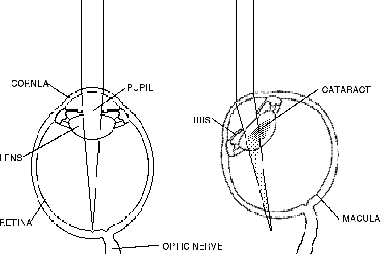Alaska Blind Child Discovery
Amblyopia Defined
Home

The eye on the right is at risk
for three types of amblyopia![]()
1) deprivational from congenital cataract (ICD 368.02)
2) refractive from unequal farsightedness due to shorter eye (ICD 368.03)
3) strabismic from misaligned images (ICD 368.01) Pronunciation Audio Clip
Pronunciation Audio Clip
ABCD History
Kids Eye Disorders
Amblyopia
Vision Screening
Issues
ABCD Clinics
References
Contact ABCD
Eye doctors and orthoptists want
each child to grow up with the healthiest visual system possible. This goal
requires the close cooperation of parents, pediatricians, primary doctors,
optometrists, school nurses and health aids and the professionals who deal
with visually impaired babies.
At birth, a normal infant has relatively poor vision in the range of 20/2000!
Under normal conditions, the visual system improves
so that 20/20 vision might be attained by school age and retained after
age 10 years. The child's brain gradually learns the best vision it receives
from the eyes over the first decade. Disruption of brain visual development
is called AMBLYOPIA. A common, but ambiguous term for amblyopia is "lazy
eye." If a child develops amblyopia and fails to receive intensive
treatment before the age of ten, permanent brain visual loss results
for one or each eye! Treatment of amblyopia is the specialty of orthoptists
and pediatric ophthalmologists.
CAUSES OF AMBLYOPIA: Amblyopia can result from three main causes: 1) unformed
images, 2) unfocused images and/or 3) misaligned images. All three are shown
in the figure. Nystagmus is another potential cause.
Deprivational Amblyopia is caused by untreated unformed image visual development.
This may be due to congenital cataracts or opacities in the lens of one
or both eyes. An infant with a cataract sees as if looking through a Kleenex®;
light, dark and color or close large shapes are all that can be seen. Cataracts
in infants need urgent care with surgical removal, optical rehabilitation
with glasses or contact lenses (by age 1 week to 4 months) and a decade
of close monitoring to attain best vision.
Refractive Amblyopia is caused by untreated poorly
focused eyes. This can be due to high
or unequal amounts of far-sightedness (hyperopia), near-sightedness
(myopia), astigmatism or unequally focused eyes (anisometropia). Such children
can be detected by distance vision chart failure when they become verbal
(age 3-5). Ideally refractive amblyopia is detected and treated even earlier.
Such children might like to sit close to TV or hold objects very close.
Strabismic Amblyopia is caused by misaligned eyes in children. Strabismus
includes conditions commonly called "cross-eyed,", "wall-eyed,"
or "squint." Rather than suffer with double vision, a child's
brain frequently suppresses or "turns off" the brain image from
the non-dominant eye. Strabismic amblyopia can be treated by combinations
of drops, glasses, patching and/or eye muscle surgery.
A fourth form of amblyopia may be due to nystagmus, or wiggling eyes.
DETECTION: Within the first
days after birth, part of each baby's first physical exam is the "red
reflex" an abnormality of which could indicate cataract or tumor. A
part of routine pre-school pediatric check-ups is observations of red reflex
(Bruckner Test), eye movements
and alignment and the ability of each eye to independently follow and interesting
object. Parents should look for Warning Signs and pediatricians should look for Risk Factors. Literate children may be screened with acuity
tests and depth perception tests. Severe amblyopic conditions should
be detected in pre-verbal children using a Photoscreening device, also.
TREATMENT: An analogy can be drawn between
amblyopia treatment and teaching a child to swim in the deep end. Until
that child is old enough (10) and an experienced swimmer, a parent will
either protect them with life-preservers, watch them very closely, or both
depending on age. Combinations of patching, dilating eye drops (Atropine),
glasses or eye muscle surgery act like life preservers for the visual
development of one or both eyes and frequent eye exams is like close
observation of a fledgling swimmer. Check www.jaeb.org or www.aapos.org.
Amblyopia afflicts approximately 5% of children. With proper vision screening
and early, persistent treatment, amblyopia should be entirely treatable.
Infants' eyes should be examined as a part of their initial pediatric exam;
cataracts or other serious causes of deprivational amblyopia can be detected
at day one. Children who fail an eye screening by age one year should receive
a thorough confirmatory
eye exam by an eye doctor including dilating drops, refraction and thorough
retina and lens exam. For families that can afford it, we frequently recommend
that each child should receive at least one dilated eye exam before age
5 years by an eye doctor experienced with children even if no symptoms or
vision screen failures are encountered. Our goal is to detect and treat
all amblyopia so children see as well as possible.
Doctors Robert Arnold, Robin Grendahl and Kevin Winkle: ABCD
Coordinating Center, Anchorage, Alaska
